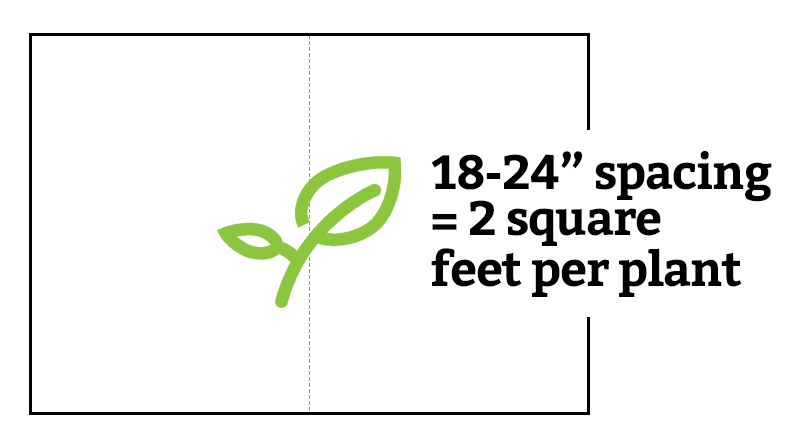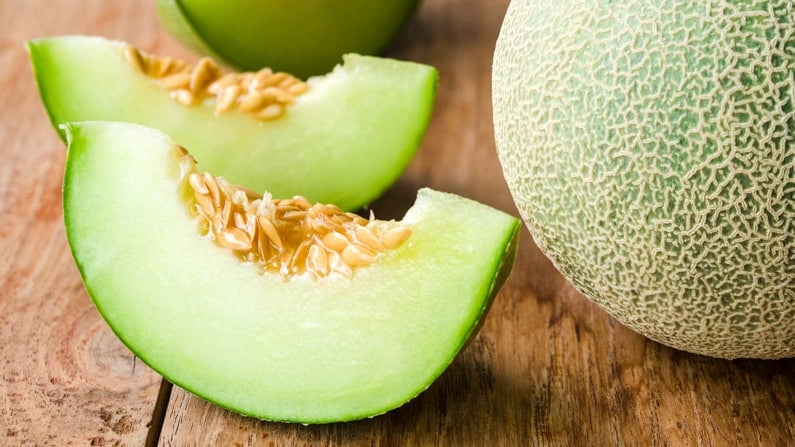Step-by-Step Guide to Growing Melons in Your Square Foot Garden
I bet you have a fond memory of eating melons fresh from the garden or farmer’s market…
- Maybe you remember eating watermelons at summer barbeques … who can forget the deliciously sticky chins and fingers?!
- Or maybe you can still recall the floral, musky smell of a cantaloupe fresh from the garden or the clean, sweet taste of your first crisp honeydew.
Even if you have a small vegetable garden or only have room for a few plants, you can relive those delicious memories by growing melons in your square foot garden or raised beds!
Keep reading to discover my best tips for growing melons, from selecting the right variety to planting and tending them throughout the season.
Heads up: I’ll earn a small commission if you buy something after clicking a link in this post. I only link to products I’d recommend to my best friend.

Could you use a FREE square foot spacing guide that’s easy to use even if you’re new to square foot gardening? Click here to get started!
How to grow melons in a square foot garden
It’s important to choose the right variety to ensure a good harvest.
- Melons are warm-season crops, and they need a lot of hot weather to grow their best.
- Some varieties are better suited to cooler climates than others.
- Melons do best in the long, hot days of summer when the temperature is above 75°F, and there’s plenty of sun.
- If you live in a cool climate, you may need to use a plastic mulch to warm the soil for your melons, and you may also want to cover your plants with row cover on cooler nights.
- Melons need a lot of space to grow, so you need to plant them where they’ll have room to spread out or plan on providing them a tall, sturdy trellis.

Melon growing basics
Botanical name: Cucumis melo and Citrullus lanatus
Melons are members of the Cucumber (Cucurbitacea) family
Melon plant height: 24 inches if grown on the ground. The vines reach 6-8 feet tall on a trellis. If space is limited, plan to grow your melons on a trellis.
Melons are frost-tender annuals.
When can you plant melons? Plant your transplants after all danger of frost has passed.
BONUS: Here’s how to make square foot gardening easy. Get a FREE Square Foot Garden Spacing Chart when you join my newsletter.
When can you start harvesting melons? After transplanting, you’ll harvest your first melons in 60-90 days. Check your seed packet for the exact number of days.
What are the best melons for small gardens? Look for smaller varieties like sugar baby watermelon, which will be easier to grow with limited space. (My personal favorite is the seedless watermelon).
Before you decide what variety to grow, you should check with your local Cooperative Extension office (U.S. only) to see what varieties will grow well in your area.
And if diseases like wilt have been a problem for you in the past, try growing disease-resistant varieties.

How to plant melons in your square foot garden
Start your seeds indoors 4-6 weeks before your last frost.
- Plant your seeds 1/2″ deep.
- Keep the soil temperature at 75-95°F while germinating them for the best results.
- They should germinate in 5-10 days.
- Melon seeds will last about 5-6 years.
Transplant your seedlings when all danger of frost has passed.
Plant transplants outdoors when your soil is at least 65-75°F Check your soil temperature with a soil thermometer to be sure.
Can you succession plant melons? If your growing season is long enough, you can plant melons every two weeks to extend your harvest.
Related: How to grow sweet potatoes.
Melon spacing in a square foot garden
Spacing for melons in a square foot garden is one plant per two square feet.
This plant spacing works ONLY when you grow the melons on a trellis.
Sick of Googling square foot spacing? Snag a helpful FREE square foot gardening plant chart now.
1 plant per 2 square feet

Once you know the proper spacing, it’s time to mark out your holes in your garden bed and transplant your seedlings.
- You don’t need any special tools or equipment to set out your transplants.
- I use a measuring tape and a trowel to plant each seedling.
Related: Square foot garden spacing for more than 20 vegetables.
How to trellis your melons
- Provide a strong enough trellis to support the fruit’s weight.
- The trellis should be at least eight feet tall.
- And you must support the fruit with netting or a sling.
Watch a video from Grow Your Greens on trellising your melons
Melon growing tips
How much sun do melons need? They need 6-8 hours of sun per day.
Melons love the heat🔥, so be sure to place your melons in a spot where they won’t get shaded by taller plants like tomatoes, corn, or pole beans.
- If you live in a short-season area, melons will grow best if you can keep them warm. Use plastic mulch to warm the soil in the spring and suppress weeds in the summer.
- If you use plastic mulch, you’ll need to run drip irrigation or a soaker hose under the plastic to water your plants.
- And you may also want to cover your melons with floating row cover on cooler nights. Remove row covers when the plants begin to flower.
Download my FREE Square Foot Spacing Chart as a bonus for joining my newsletter.
How much water do melons need?
Melons need 1 to 2 inches of water per week.
From the time you plant them until they start producing fruit, they need a steady supply of water. Keep the soil evenly moist but not soggy. Once the fruit sets, make sure they’re getting at least an inch per week.
How do I fertilize melons?
- Melons tend to have low nitrogen requirements, but the nutritional needs of the fruit can tax the plants.
- If the leaves turn pale during the growing season, fertilize them with a side-dressing of a complete fertilizer that’s high in nitrogen.
Harvesting melons
How do you tell when melons are ripe?

Muskmelons and Cantaloupes
Cantaloupes and muskmelons may detach from the vine on their own. But if they don’t, check the fruit for a sweet melon-y aroma. The blossom end will also feel a bit softer than the rest of the melon when they’re ripe.
Honeydew melon
When the rind turns from green to a pale yellow, it’s probably ripe. To be sure, run your hand over the skin. It should feel smooth and waxy. Press the bottom of the melon with your thumb. If it gives slightly, then it’s ready to eat.
Honeydews don’t detach like muskmelons, so cut your honeydews from the vine with a knife or pruning shears when they’re ripe.
Watermelons
Much like honeydews, watermelons won’t have a scent or slip from the vine. So, if you’re growing watermelon, keep an eye on the leaf and tendril closest to the melon. Once they turn brown, your watermelon has ripened and is ready to pick. You may also notice a yellow spot on the rind where the melon rests on the ground.
Storing melons

- Whole, ripe melons should be stored at room temperature until they are ready to eat.
- Once the fruit is fully ripened and soft enough for eating, store it in your refrigerator. That will help extend its shelf life up to one week.
- Cut melons will usually last about three days in the fridge.
- If you have some ripe melons and aren’t able to use them right away, cut or dice them into small pieces and freeze them.
Find the right spacing for your vegetables in 2 minutes. Snag your FREE Square Foot Garden Spacing Chart now.
Download your free square foot gardening chart
It’s easy to always use the right spacing for your vegetables. Just download the Square Foot Gardening Chart and:
- Print it.
- Put it in a handy spot.
- Pull it out when you’re ready to plant seeds or transplants.
It really is that easy!
Here’s a sneak peek of your chart:

Your turn: Have you grown melons in a square foot garden?
Have you used square foot spacing for your melons before?
Tell me how it went! Share in a comment below.
Frequently asked questions about growing melons
Are melons easy to grow?
With the right conditions, melons can be a bountiful crop for gardeners. Melons are relatively easy to grow if you give them what they need most…warmth🌞. They need about 100 frost-free days to produce fruit. Melons are easy to start from seed but should be started inside unless you have a long growing season.
They’ll do best in full sun with plenty of air circulation, where they’ll stay warm and dry to help prevent the spread of diseases. Plant them in loose, well-drained soil rich in organic matter, then wait patiently until harvest time!
How much space do melons need?
Melons need plenty of space. Most melons will grow 6-8′ long. To save space, grow up instead of out by growing them on a trellis. Plant them 24 inches apart. Make sure you tie the vines to the trellis as they grow, so they’re fully supported and stay within the bounds of the trellis. If you do trellis your melons, you’ll need to support each fruit with netting or a sling.
Can you grow melons in raised beds?
Raised beds are perfect for growing melons. Melons thrive in the warm soil raised beds provide. You’ll need at least a 4′ x 6′ area to grow melons on the ground. To save space in raised beds, grow them on a sturdy trellis.
Do melons climb?
Melon vines send out clinging tendrils that will climb if you give them a sturdy support system.
How many melons does a plant produce?
Most melons will produce 2-4 fruits per plant.
How long does it take for a watermelon to grow to full size?
The time it takes for a watermelon to mature can be anywhere from 60 to 90 days after planting. Check your seed packet for the exact number of days to maturity.
How late can you plant cantaloupe?
It depends on your average first frost date. Most cantaloupes take 60 to 90 days to produce fruit, and they can’t tolerate frost. So, you’ll need to plant them 60-90 days before your first frost.



How do I know when my melons are ripe?
Hi Rosalyn,
I added that info to the article. You’ll find it under the FAQs: https://simplysmartgardening.com/square-foot-garden-melons#melons-faqs